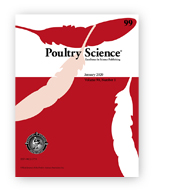Unraveling the role of type 1 fimbriae in Salmonella pathogenesis: insights from a comparative analysis of Salmonella Enteritidis and Salmonella Gallinarum
Agata Mikołajczyk-Martinez; Maciej Ugorski
Poultry Science
Ministerial score = 140.0
Journal Impact Factor (2023) = 4.4 (Q1)
 Significant differences in pathogenicity between Salmonella Enteritidis and Salmonella Gallinarum exist despite the fact that S. Gallinarum is a direct descendant of S. Enteritidis. It was hypothesized that such various properties may be in part the result of differences in structure and functions of type 1 fimbriae (T1Fs). In S. Enteritidis, T1Fs bind to oligomannosidic structures carried by host cell glycoproteins and are called mannose-sensitive T1Fs (MST1F). In S. Gallinarum, T1Fs lost ability to bind such carbohydrate chains, and were named mannose-resistant MRT1Fs (MRT1F). Therefore, the present study was undertaken to evaluate the role of MST1Fs and MRT1Fs in the adhesion, invasion, intracellular survival and cytotoxicity of S. Enteritidis and S. Gallinarum toward chicken intestinal CHIC8-E11cells and macrophage-like HD11 cells. Using mutant strains: S. Enteritidis fimH::kan and S. Gallinarum fimH::kan devoid of T1Fs and in vitro assays the following observations were made. MST1Fs have a significant impact on the chicken cell invasion by S. Enteritidis as MST1F-mediated adhesion facilitates direct and stable contact of bacteria with host cells, in contrast to MRT1Fs expressed by S. Gallinarum. MST1Fs as well as MRT1Fs did not affected intracellular viability of S. Enteritidis and S. Gallinarum. However, absolute numbers of intracellular viable wild-type S. Enteritidis were significantly higher than S. Enteritidis fimH::kan mutant and wild-type S. Gallinarum and S. Gallinarum fimH::kan mutant. These differences, reflecting the numbers of adherent and invading bacteria, underline the importance of MST1Fs in the pathogenicity of S. Enteritidis infections. The cytotoxicity of wild-type S. Enteritidis and its mutant devoid of MST1Fs to HD11 cells was essentially the same, despite the fact that the number of viable intracellular bacteria was significantly lower in the mutated strain. Using HD11 cells with similar number of intracellular wild-type S. Enteritidis and S. Enteritidis fimH::kan mutant, it was found that the lack of MST1Fs did not affect directly the cytotoxicity, suggesting that the increase in cytotoxicity of S. Enteritidis devoid of MST1Fs may be associated with crosstalk between T1Fs and other virulence factors.
Significant differences in pathogenicity between Salmonella Enteritidis and Salmonella Gallinarum exist despite the fact that S. Gallinarum is a direct descendant of S. Enteritidis. It was hypothesized that such various properties may be in part the result of differences in structure and functions of type 1 fimbriae (T1Fs). In S. Enteritidis, T1Fs bind to oligomannosidic structures carried by host cell glycoproteins and are called mannose-sensitive T1Fs (MST1F). In S. Gallinarum, T1Fs lost ability to bind such carbohydrate chains, and were named mannose-resistant MRT1Fs (MRT1F). Therefore, the present study was undertaken to evaluate the role of MST1Fs and MRT1Fs in the adhesion, invasion, intracellular survival and cytotoxicity of S. Enteritidis and S. Gallinarum toward chicken intestinal CHIC8-E11cells and macrophage-like HD11 cells. Using mutant strains: S. Enteritidis fimH::kan and S. Gallinarum fimH::kan devoid of T1Fs and in vitro assays the following observations were made. MST1Fs have a significant impact on the chicken cell invasion by S. Enteritidis as MST1F-mediated adhesion facilitates direct and stable contact of bacteria with host cells, in contrast to MRT1Fs expressed by S. Gallinarum. MST1Fs as well as MRT1Fs did not affected intracellular viability of S. Enteritidis and S. Gallinarum. However, absolute numbers of intracellular viable wild-type S. Enteritidis were significantly higher than S. Enteritidis fimH::kan mutant and wild-type S. Gallinarum and S. Gallinarum fimH::kan mutant. These differences, reflecting the numbers of adherent and invading bacteria, underline the importance of MST1Fs in the pathogenicity of S. Enteritidis infections. The cytotoxicity of wild-type S. Enteritidis and its mutant devoid of MST1Fs to HD11 cells was essentially the same, despite the fact that the number of viable intracellular bacteria was significantly lower in the mutated strain. Using HD11 cells with similar number of intracellular wild-type S. Enteritidis and S. Enteritidis fimH::kan mutant, it was found that the lack of MST1Fs did not affect directly the cytotoxicity, suggesting that the increase in cytotoxicity of S. Enteritidis devoid of MST1Fs may be associated with crosstalk between T1Fs and other virulence factors.
DOI:10.1016/j.psj.2023.102833









